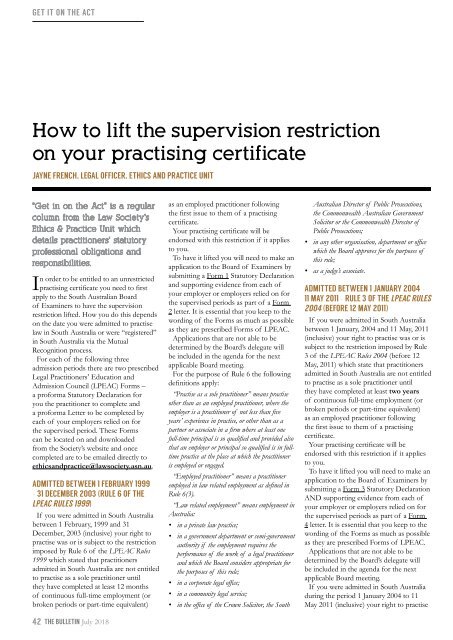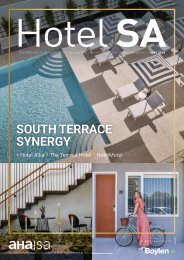LSB July 2018_Web
Create successful ePaper yourself
Turn your PDF publications into a flip-book with our unique Google optimized e-Paper software.
GET IT ON THE ACT<br />
How to lift the supervision restriction<br />
on your practising certificate<br />
JAYNE FRENCH, LEGAL OFFICER, ETHICS AND PRACTICE UNIT<br />
“Get in on the Act” is a regular<br />
column from the Law Society’s<br />
Ethics & Practice Unit which<br />
details practitioners’ statutory<br />
professional obligations and<br />
responsibilities.<br />
In order to be entitled to an unrestricted<br />
practising certificate you need to first<br />
apply to the South Australian Board<br />
of Examiners to have the supervision<br />
restriction lifted. How you do this depends<br />
on the date you were admitted to practise<br />
law in South Australia or were “registered”<br />
in South Australia via the Mutual<br />
Recognition process.<br />
For each of the following three<br />
admission periods there are two prescribed<br />
Legal Practitioners’ Education and<br />
Admission Council (LPEAC) Forms –<br />
a proforma Statutory Declaration for<br />
you the practitioner to complete and<br />
a proforma Letter to be completed by<br />
each of your employers relied on for<br />
the supervised period. These Forms<br />
can be located on and downloaded<br />
from the Society’s website and once<br />
completed are to be emailed directly to<br />
ethicsandpractice@lawsociety.asn.au.<br />
ADMITTED BETWEEN 1 FEBRUARY 1999<br />
– 31 DECEMBER 2003 (RULE 6 OF THE<br />
LPEAC RULES 1999)<br />
If you were admitted in South Australia<br />
between 1 February, 1999 and 31<br />
December, 2003 (inclusive) your right to<br />
practise was or is subject to the restriction<br />
imposed by Rule 6 of the LPEAC Rules<br />
1999 which stated that practitioners<br />
admitted in South Australia are not entitled<br />
to practise as a sole practitioner until<br />
they have completed at least 12 months<br />
of continuous full-time employment (or<br />
broken periods or part-time equivalent)<br />
42 THE BULLETIN <strong>July</strong> <strong>2018</strong><br />
as an employed practitioner following<br />
the first issue to them of a practising<br />
certificate.<br />
Your practising certificate will be<br />
endorsed with this restriction if it applies<br />
to you.<br />
To have it lifted you will need to make an<br />
application to the Board of Examiners by<br />
submitting a Form 1 Statutory Declaration<br />
and supporting evidence from each of<br />
your employer or employers relied on for<br />
the supervised periods as part of a Form<br />
2 letter. It is essential that you keep to the<br />
wording of the Forms as much as possible<br />
as they are prescribed Forms of LPEAC.<br />
Applications that are not able to be<br />
determined by the Board’s delegate will<br />
be included in the agenda for the next<br />
applicable Board meeting.<br />
For the purpose of Rule 6 the following<br />
definitions apply:<br />
“Practise as a sole practitioner” means practise<br />
other than as an employed practitioner, where the<br />
employer is a practitioner of not less than five<br />
years’ experience in practice, or other than as a<br />
partner or associate in a firm where at least one<br />
full-time principal is so qualified and provided also<br />
that an employer or principal so qualified is in fulltime<br />
practice at the place at which the practitioner<br />
is employed or engaged.<br />
“Employed practitioner” means a practitioner<br />
employed in law related employment as defined in<br />
Rule 6(3).<br />
“Law related employment” means employment in<br />
Australia:<br />
• in a private law practice;<br />
• in a government department or semi-government<br />
authority if the employment requires the<br />
performance of the work of a legal practitioner<br />
and which the Board considers appropriate for<br />
the purposes of this rule;<br />
• in a corporate legal office;<br />
• in a community legal service;<br />
• in the office of the Crown Solicitor, the South<br />
Australian Director of Public Prosecutions,<br />
the Commonwealth Australian Government<br />
Solicitor or the Commonwealth Director of<br />
Public Prosecutions;<br />
• in any other organisation, department or office<br />
which the Board approves for the purposes of<br />
this rule;<br />
• as a judge’s associate.<br />
ADMITTED BETWEEN 1 JANUARY 2004 –<br />
11 MAY 2011 – RULE 3 OF THE LPEAC RULES<br />
2004 (BEFORE 12 MAY 2011)<br />
If you were admitted in South Australia<br />
between 1 January, 2004 and 11 May, 2011<br />
(inclusive) your right to practise was or is<br />
subject to the restriction imposed by Rule<br />
3 of the LPEAC Rules 2004 (before 12<br />
May, 2011) which state that practitioners<br />
admitted in South Australia are not entitled<br />
to practise as a sole practitioner until<br />
they have completed at least two years<br />
of continuous full-time employment (or<br />
broken periods or part-time equivalent)<br />
as an employed practitioner following<br />
the first issue to them of a practising<br />
certificate.<br />
Your practising certificate will be<br />
endorsed with this restriction if it applies<br />
to you.<br />
To have it lifted you will need to make an<br />
application to the Board of Examiners by<br />
submitting a Form 3 Statutory Declaration<br />
AND supporting evidence from each of<br />
your employer or employers relied on for<br />
the supervised periods as part of a Form<br />
4 letter. It is essential that you keep to the<br />
wording of the Forms as much as possible<br />
as they are prescribed Forms of LPEAC.<br />
Applications that are not able to be<br />
determined by the Board’s delegate will<br />
be included in the agenda for the next<br />
applicable Board meeting.<br />
If you were admitted in South Australia<br />
during the period 1 January 2004 to 11<br />
May 2011 (inclusive) your right to practise


















